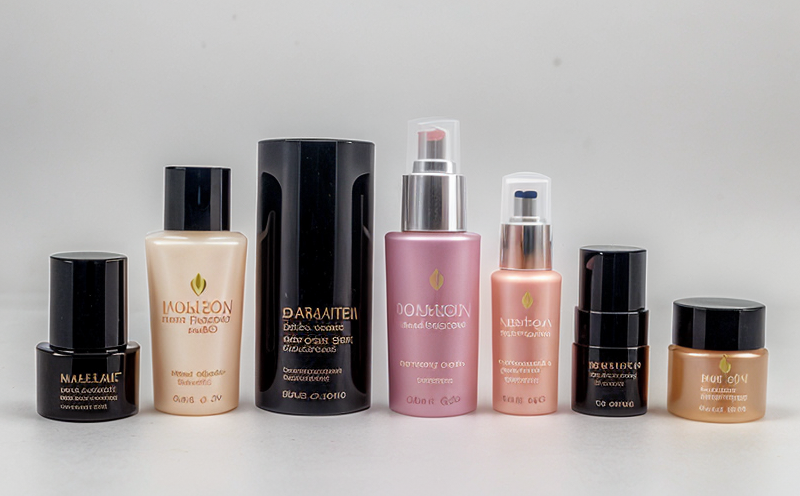Endocrine Disruptor Leaching Testing from Packaging
The growing concern over endocrine disruptors (EDs) in cosmetics and personal care products has led to stringent regulatory measures aimed at ensuring consumer safety. One critical aspect of this is the assessment of leaching from packaging materials into the contents they contain, particularly in relation to EDs. This service focuses on identifying potential endocrine-disrupting compounds that may migrate from packaging materials into cosmetic products during storage and use.
Understanding the interaction between packaging and product content is essential for ensuring compliance with international standards such as ISO 15902, which specifically addresses the migration of substances from packaging to food contact articles. The service encompasses testing methodologies that are aligned with these standards, providing a robust framework for evaluating the safety profile of cosmetic packaging.
The process involves several key steps including sample preparation, instrumental analysis using advanced chromatographic techniques like Liquid Chromatography-Mass Spectrometry (LC-MS), and statistical evaluation to quantify migration levels. The goal is not only to detect trace amounts of leachable materials but also to assess their potential impact on human health.
Our team employs state-of-the-art facilities equipped with high-resolution analytical instruments capable of detecting even minute concentrations of EDs. By leveraging these resources, we can provide comprehensive data that helps clients make informed decisions about material selection and formulation design.
The importance of this service cannot be overstated given the increasing awareness among consumers regarding environmental health issues related to synthetic chemicals used in manufacturing processes. Regulatory bodies worldwide are increasingly focusing on reducing exposure risks associated with certain types of plastics and other materials commonly found in packaging applications within cosmetics industries.
By offering tailored solutions based on client needs, our laboratory ensures accurate testing results that meet both internal quality control requirements as well as external regulatory expectations. This comprehensive approach allows us to support clients throughout every phase of product development from initial concept through final approval.
| Test Methodologies | Description |
|---|---|
| Liquid Chromatography-Mass Spectrometry (LC-MS) | Analyzes trace amounts of endocrine-disrupting compounds in samples. |
| Statistical Analysis | Evaluates the significance and impact of detected leachables on health. |
The above table outlines some key methodologies used during this service. These methods are integral to our approach towards ensuring accurate and reliable results that adhere strictly to global standards.
Scope and Methodology
- Sampling of cosmetic packaging materials
- Preparation and conditioning of samples for analysis
- Analytical determination of endocrine-disrupting compounds using LC-MS technology
- Evaluation of migration levels based on accepted thresholds defined by relevant standards (ISO 15902)
| Acceptance Criteria | Description |
|---|---|
| Migration Limits | Maximum allowable concentration of leachables in cosmetic products. |
| Safety Thresholds | Concentration levels below which no adverse effects are expected on human health. |
The acceptance criteria listed above guide our laboratory’s testing procedures to ensure compliance with international regulations and best practices. This ensures that all products tested meet stringent safety standards before being released into the market.
Benefits
- Enhanced Product Safety: Identification of harmful substances prevents them from entering the supply chain.
- Regulatory Compliance: Ensures adherence to international standards like ISO 15902.
- Risk Management: Early detection allows for corrective actions before issues escalate.
- Market Access: Meeting stringent requirements opens up opportunities in global markets.
The benefits of this service extend beyond mere compliance; they contribute significantly towards safeguarding public health while maintaining product integrity. By implementing rigorous testing protocols, businesses can build trust with consumers and regulators alike.
Use Cases and Application Examples
- Development Phase: Identification of potential risks during R&D stages.
- Manufacturing Process: Monitoring compliance throughout production lines.
- Packaging Design: Optimization of packaging materials for minimum leaching.
- Quality Control: Continuous monitoring post-launch to ensure ongoing safety standards are maintained.
| Application Scenario | Description |
|---|---|
| New Product Launch | Detection of leachable compounds prior to market entry. |
| Recall Investigations | Evaluation of recalled products to determine root causes. |
| Supply Chain Audits | Sampling and analysis of incoming materials for compliance verification. |
The use cases highlighted here demonstrate how this service can be leveraged at various stages of the product lifecycle. From research to retail, our testing ensures that every step aligns with industry best practices.





